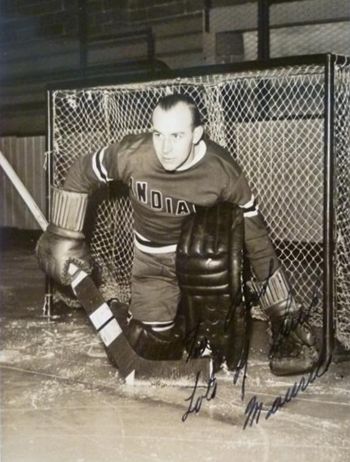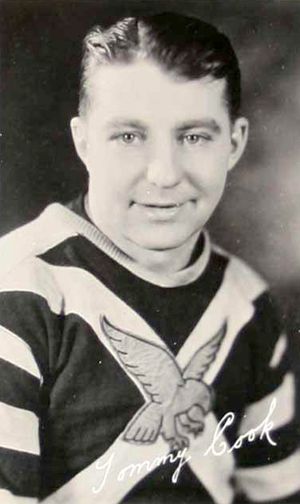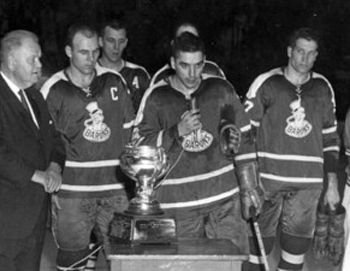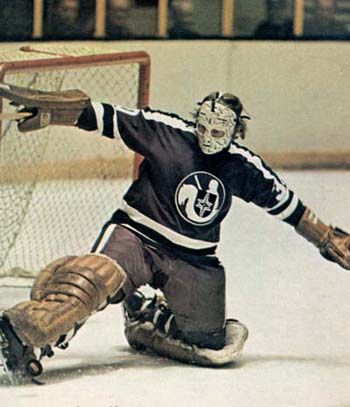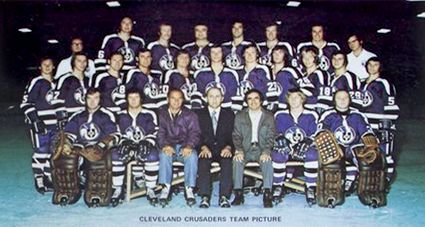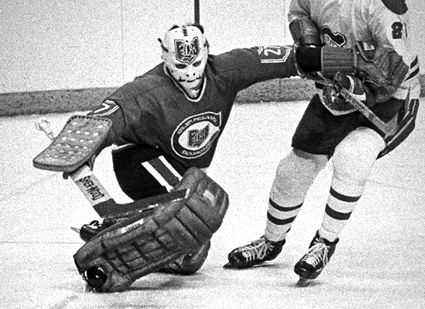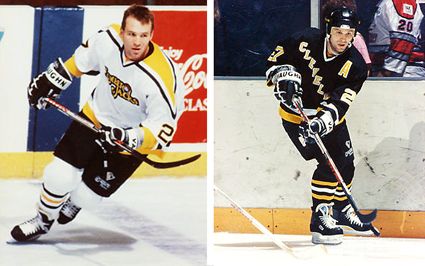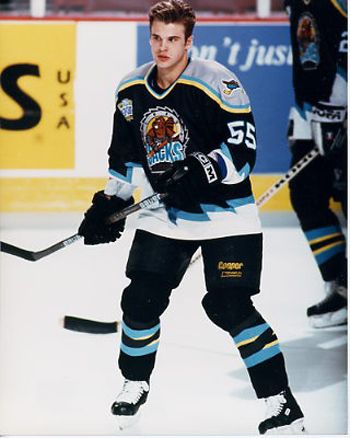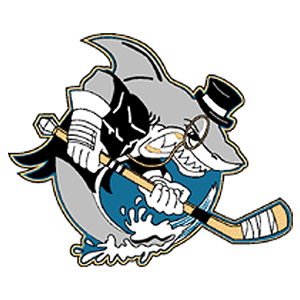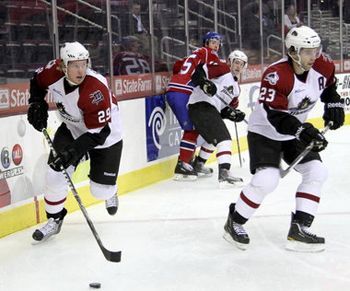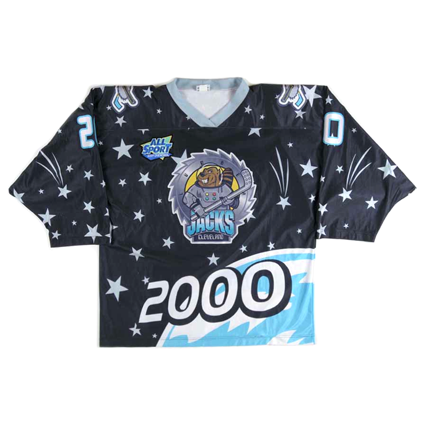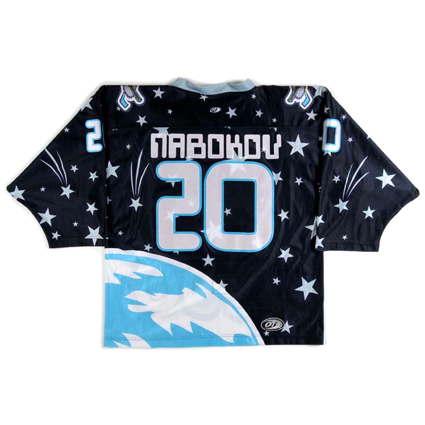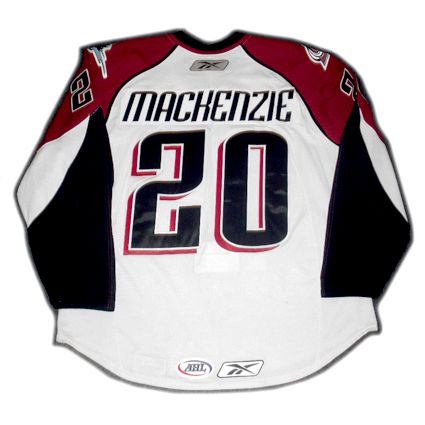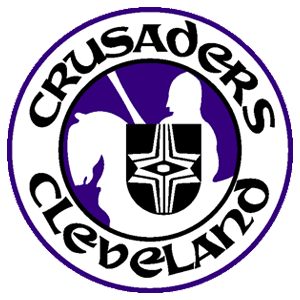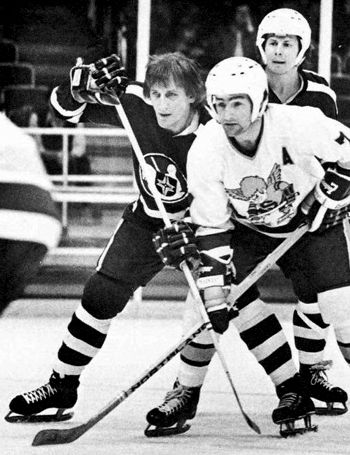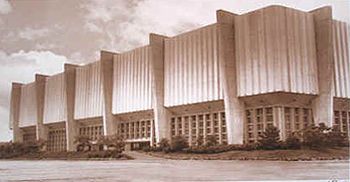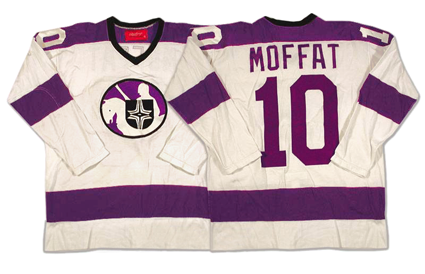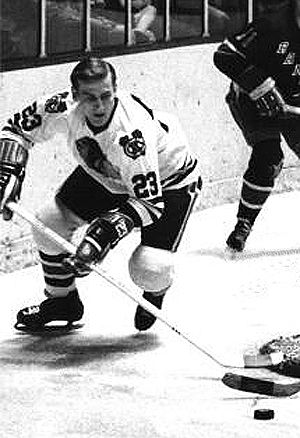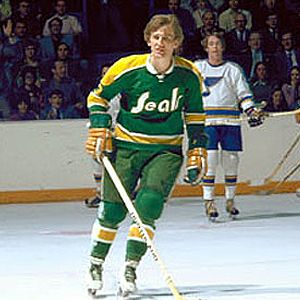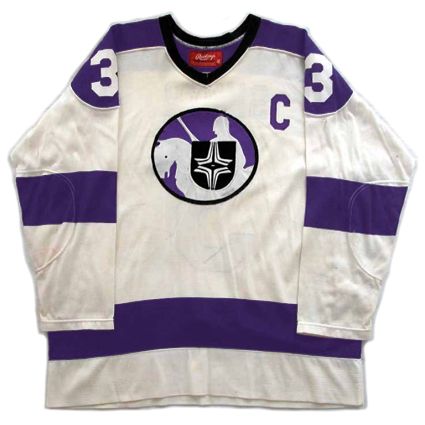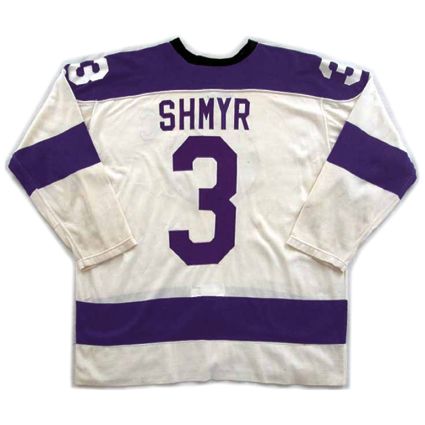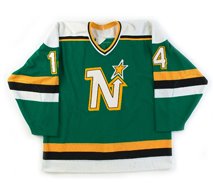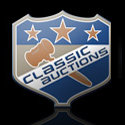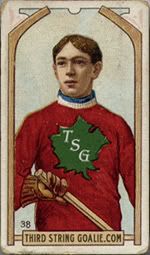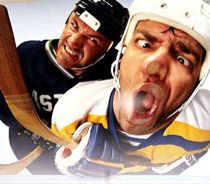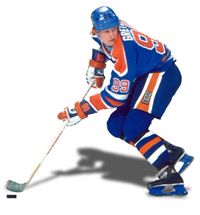While the Lumberjacks had averaged between 8,200 and 9,000 fans their first six seasons, their attendance had dropped to 4,200 in their final season, which proved to be the equal of the new Barons best season, due in part to the team's struggles on the ice, as they had only one winning season in five years, winning less than 30 games three times and only qualifying for the playoffs once, that being a first round exit.
Showing posts with label Cleveland Crusaders. Show all posts
Showing posts with label Cleveland Crusaders. Show all posts
Monday, July 20, 2015
1999-00 Cleveland Lumberjacks Evgeni Nabokov Jersey
Before we visit the future, we must visit the past in order to understand where we are coming from. The history of hockey in Cleveland can be traced back to the Cleveland Athletic Club, the first winners of the MacNaughton Cup in 1914.
The first professional team to call Cleveland home was the Cleveland Indians of the International Hockey League, who relocated from Kitchener, Ontario in 1929 where they were known as the Dutchmen. They were rather successful their first season, going 24-9-9 and won the league championship, defeating Buffalo 3 games to 1. That would be the high point for the Indians, as they would slip down the standings, finishing last or next to last their final three seasons before being renamed the Cleveland Falcons in 1934.
Moe Roberts of the Cleveland Indians hockey team
The Falcons would play two seasons in the IHL, which then merged with the Canadian American Hockey League to form the new International-American Hockey League for the 1936-37 season.
Tommy Cook of the Cleveland Falcons
After one more year as the Falcons, the franchise was again renamed, this time as the Cleveland Barons for the 1937-38 season. The Barons would win the Calder Cup as IAHL champions in 1939 before the league shortened it's name to simply the American Hockey League for the 1940-41 season.
The Barons would provide Cleveland with it's longest, most stable and successful period of hockey in the city's history, playing 36 seasons, during which time they won nine championships, those coming in 1939, 1941, 1945, 1948, 1951, 1953, 1954, 1957 and 1964 in front of standing room only crowds in what was the Golden Age of Cleveland hockey. So successful was the franchise, that at one point in the early 1950's ownership tried to apply for entrance into the National Hockey League and so confident their owner that the Barons issued a challenge to the NHL for the right to play for the Stanley Cup!
The Cleveland Barons accepting another of their nine Calder Cups
Eventually, ownership of the franchise passed to Nick Mileti, who became the owner of the Cleveland entry in the new World Hockey Association in 1972. The combination of the competition for the fans of Cleveland, who now had a major league team to support for the first time, and the dramatic increase in competition for players against not only the new WHA, but the expanding NHL, spelled the end for the Barons, as Mileti moved the team to Florida in the middle of the 1972-73 season.
Mileti's new WHA club, the Cleveland Crusaders, made a splash by luring goaltender Gerry Cheevers away from the Stanley Cup champion Boston Bruins.
Gerry Cheevers
The team had a good first season, but moderate attendance for four seasons, combined with issues with their new arena located too far from the city and the impending arrival of the relocating California Golden Seals of the NHL, sent the Crusaders out of town after just four seasons.
The 1974-75 Cleveland Crusaders of the WHA
The club that drove the Crusaders out of town revived the Cleveland Barons name, but did not come anywhere near duplicating the original Barons success, as they not only brought all the competitive issues the Golden Seals suffered on the ice with them from California, but compounded those by moving into the problematic Richfield Coliseum. The doomed Barons only lasted two troubled seasons, finishing with a 47-87-26 record overall. After the 1977-78 season, the Barons merged with the Minnesota North Stars, who played all their games in Minnesota, leaving Cleveland without pro hockey for the next 14 seasons.
Goaltender Gilles Meloche anchored the NHL's Cleveland Barons
Cleveland would be without professional hockey until the 1992-93 season when the Muskegon Lumberjacks of the IHL relocated to Ohio and were the top affiliate of the Pittsburgh Penguins.
The Lumberjacks sharp jerseys based on the Penguins jerseys of the early 1990's
The Lumberjacks had five winning seasons in their nine years of existence, including four seasons of 90 points or more, but managed only one deep playoff run. That came in 1997, when they reached the third round of the Turner Cup playoffs. At the end of the 2000-01 season, the IHL, which had been around since 1945, collapsed due to a combination of expanding too quickly and not nearly enough teams having affiliations with NHL franchises. While 6 of the 11 IHL franchises were accepted into the AHL, Cleveland was not among those, and the Lumberjacks run came to an end despite their affiliation with the Minnesota Wild.
The trendy late 90's teal and black look of the Lumberjacks, complete with Beaver logo and buzzsaw waist stripe
Cleveland was not left without hockey though, as the San Jose Sharks of the NHL purchased their AHL affiliate, the Kentucky Thoroughblades, and relocated them to Cleveland, where they revived the Cleveland Barons name once again.
While the Lumberjacks had averaged between 8,200 and 9,000 fans their first six seasons, their attendance had dropped to 4,200 in their final season, which proved to be the equal of the new Barons best season, due in part to the team's struggles on the ice, as they had only one winning season in five years, winning less than 30 games three times and only qualifying for the playoffs once, that being a first round exit.
While the Lumberjacks had averaged between 8,200 and 9,000 fans their first six seasons, their attendance had dropped to 4,200 in their final season, which proved to be the equal of the new Barons best season, due in part to the team's struggles on the ice, as they had only one winning season in five years, winning less than 30 games three times and only qualifying for the playoffs once, that being a first round exit.
The Cleveland Sharks logo
When the Sharks relocated the franchise to Worcester, Massachusetts for the 2006-07 season, Cleveland was left without a team for just one season before the inactive Utah Grizzlies AHL franchise was purchased and moved to Cleveland. The new franchise was named the Lake Erie Monsters where they remain today as affiliates of fellow Ohio residents, the NHL's Columbus Blue Jackets. Unlike several of their immediate predecessors, the Monsters have enjoyed a steady increase in attendance (from 5900 in 2008 to 8300 in the just completed 2014-15 schedule) over their now eight seasons despite just one lone playoff appearance which ended after just one round. Still, the club hopes to maintain a steady presence as they write their chapter in the history of hockey in Cleveland.
The Lake Erie Monsters in action
Today's featured jersey is a 1999-00 Cleveland Lumberjacks Evgeni Nabokov jersey. This wild jersey is emblematic of the many special occasion jerseys seen in the minor leagues. Special one-off designs can often be seen on various holidays that occur during the hockey season, such as Halloween, Christmas, St. Patrick's Day and Valentine's Day in particular which often results in the players having to sacrifice their dignity as they are forced to wear pink jerseys with red hearts.
Other club's will create a special jersey simply to go along with a special themed promotion, such as jerseys made to look like tuxedos, cowboys, pirates, prison uniforms and guards, cows or the clothing worn by Ronald McDonald, Don Cherry, Bob Uecker and Michael Jackson, which included the players each wearing one white glove!
Tributes and awareness themes have also spawned many sets of unique jerseys, such as those for military tribute or breast cancer awareness nights, with the jerseys regularly auctioned off to the fans following the game.
In 1999 the approach of the Millennium occupied the minds of many, particularly the threat of computers world wide crashing due the "Y2K" scare - to not being able to recognize the difference between "2000" and "1900" due to only having two digits to signify the year.
Major League Baseball recognized the upcoming flipping of the calendar with the notorious "Turn Ahead the Clock" promotion, wearing jerseys from twenty some years in the future, and the Lumberjacks also got into the spirit of the event with their own Millennium special occasion jersey, filled with futuristic imagery and decorated with the inspired choice of the same font used on bank checks, "MICR".
Bonus jersey: Today's bonus jersey is a 2008-09 Lake Erie Monsters Aaron Mackenzie jersey from the most recent professional team to call Cleveland home. This jersey illustrates the modern template and lines of the newest generation of Reebok designed jerseys, which have moved away from the classic horizontal striping of hockey jerseys of the past.
While the Monsters regularly wear their modern jerseys, they have also worn AHL Baron's throwback jerseys as well as WHA Crusaders throwbacks in recognition of the team's that built a foundation of Cleveland hockey history.
Today's video section begins with the Cleveland Baron's star Fred Glover, and AHL legend and one of the best players you have never heard of.
Here is a look at the history of the original Barons and the WHA's Crusaders.
Sunday, July 20, 2014
1999-00 Cleveland Lumberjacks Evgeni Nabokov Jersey
July by the Numbers travels to the future for jersey #20!
Before we visit the future, we must visit the past in order to understand where we are going by looking back at where we've been. The history of hockey in Cleveland can be traced back to the Cleveland Athletic Club, the first winners of the MacNaughton Cup in 1914.
The first professional team to call Cleveland home was the Cleveland Indians of the International Hockey League, who relocated from Kitchener, Ontario in 1929 where they were known as the Dutchmen. They were rather successful their first season, going 24-9-9 and won the league championship, defeating Buffalo 3 games to 1. That would be the high point for the Indians, as they would slip down the standings, finishing last or next to last their final three seasons before being renamed the Cleveland Falcons in 1934.
Moe Roberts of the Cleveland Indians hockey team
The Falcons would play two seasons in the IHL, which then merged with the Canadian American Hockey League to form the new International-American Hockey League for the 1936-37 season.
Tommy Cook of the Cleveland Falcons
After one more year as the Falcons, the franchise was again renamed, this time as the Cleveland Barons for the 1937-38 season. The Barons would win the Calder Cup as IAHL champions in 1939 before the league shortened it's name to simply the American Hockey League for the 1940-41 season.
The Barons would provide Cleveland with it's longest, most stable and successful period of hockey in the city's history, playing 36 seasons, during which time they won nine championships, those coming in 1939, 1941, 1945, 1948, 1951, 1953, 1954, 1957 and 1964 in front of standing room only crowds in what was the Golden Age of Cleveland hockey. So successful was the franchise, that at one point in the early 1950's ownership tried to apply for entrance into the National Hockey League and so confident their owner that the Barons issued a challenge to the NHL for the right to play for the Stanley Cup!
The Cleveland Barons accepting another of their nine Calder Cups
Eventually, ownership of the franchise passed to Nick Mileti, who became the owner of the Cleveland entry in the new World Hockey Association in 1972. The combination of the competition for the fans of Cleveland, who now had a major league team to support for the first time, and the dramatic increase in competition for players against not only the new WHA, but the expanding NHL, spelled the end for the Barons, as Mileti moved the team to Florida in the middle of the 1972-73 season.
Mileti's new WHA club, the Cleveland Crusaders, made a splash by luring goaltender Gerry Cheevers away from the Stanley Cup champion Boston Bruins.
Gerry Cheevers
The team had a good first season, but moderate attendance for four seasons, combined with issues with their new arena located too far from the city and the impending arrival of the relocating California Golden Seals of the NHL, sent the Crusaders out of town after just four seasons.
The 1974-75 Cleveland Crusaders of the WHA
The club that drove the Crusaders out of town revived the Cleveland Barons name, but did not come anywhere near duplicating their original Barons success, as they not only brought all the competitive issues the Golden Seals suffered on the ice with them from California, but compounded those by moving into the problematic Richfield Coliseum. The doomed Barons only lasted two troubled seasons, finishing with a 47-87-26 record overall.
Goaltender Gilles Meloche anchored the NHL's Cleveland Barons
Cleveland would be without professional hockey until the 1992-93 season when the Muskegon Lumberjacks of the IHL relocated to Ohio and were the top affiliate of the Pittsburgh Penguins.
The Lumberjacks sharp jerseys based on the Penguins jerseys of the early 1990's
The Lumberjacks had five winning seasons in their nine years of existence., including four seasons of 90 points or more, but managed only one deep playoff run, that coming in 1997, when they reached the third round of the Turner Cup playoffs. At the end of the 2000-01 season, the IHL, which had been around since 1945, collapsed due to a combination of expanding too quickly and not nearly enough teams having affiliations with NHL franchises. While 6 of the 11 IHL franchises were accepted into the AHL, Cleveland was not among those, and the Lumberjacks run came to an end.
The trendy late 90's teal and black look of the Lumberjacks, complete with Beaver logo and buzzsaw waist stripe
Cleveland was not left without hockey though, as the San Jose Sharks of the NHL purchased their AHL affiliate, the Kentucky Thoroughblades, and relocated them to Cleveland, where they revived the Cleveland Barons name once again. While the Lumberjacks had averaged between 8,200 and 9,000 fans their first six seasons, their attendance had dropped to 4,200 in their final season, which proved to be the equal of the new Barons best season, due in part to the team's struggles on the ice, as they had only one winning season in five years, winning less than 30 games three times and only qualifying for the playoffs once, that being a first round exit.
The Cleveland Sharks logo
When the Sharks relocated the franchise to Worcester, Massachusetts for the 2006-07 season, Cleveland was left without a team for just one season before the inactive Utah Grizzlies AHL franchise was purchased and moved to Cleveland, where it was named the Lake Erie Monsters where they remain today as affiliates of the NHL's Colorado Avalanche. Unlike several of their immediate predecessors, the Monsters have enjoyed a steady increase in attendance over their now seven seasons and hope to maintain a steady presence as they write their chapter in the history of hockey in Cleveland.
The Lake Erie Monsters in action
Today's featured jersey is a 1999-00 Cleveland Lumberjacks Evgeni Nabokov jersey. This wild jersey is emblematic of the many special occasion jerseys seen in the minor leagues. Special one-off designs can often be seen on various holidays that occur during the hockey season, such as Halloween, Christmas, St. Patrick's Day and Valentine's Day in particular which often results in the players having to sacrifice their dignity as they are forced to wear pink jerseys with red hearts.
Other club's will create a special jersey simply to go along with a special themed promotion, such as jerseys made to look like tuxedos, cowboys, pirates, prison uniforms and guards, cows or the clothing worn by Ronald McDonald, Don Cherry, Bob Uecker and Michael Jackson, which included the players each wearing one white glove!
Tributes and awareness themes have also spawned many sets of unique jerseys, such as those for military tribute or breast cancer awareness nights, with the jerseys regularly auctioned off to the fans following the game.
In 1999 the approach of the Millennium occupied the minds of many, particularly the threat of computers world wide crashing due the "Y2K" scare - to not being able to recognize the difference between "2000" and "1900" due to only having two digits to signify the year.
Major League Baseball recognized the upcoming flipping of the calendar with the notorious "Turn Ahead the Clock" promotion, wearing jerseys from twenty some years in the future, and the Lumberjacks also got into the spirit of the event with their own Millennium special occasion jersey, filled with futuristic imagery and decorated with the inspired choice of the same font used on bank checks, "MICR".
Bonus jersey: Today's bonus jersey is a 2008-09 Lake Erie Monsters Aaron Mackenzie jersey from the most recent professional team to call Cleveland home. This jersey illustrates the modern template and lines of the newest generation of Reebok designed jerseys, which have moved away from the classic horizontal striping of hockey jerseys of the past.
While the Monsters regularly wear their modern jerseys, they have also worn AHL Baron's throwback jerseys as well as WHA Crusaders throwbacks in recognition of the team's that built a foundation of Cleveland hockey history.
Today's video section begins with the Cleveland Baron's star Fred Glover, and AHL legend and one of the best players you have never heard of.
Here is a look at the history of the original Barons and the WHA's Crusaders.
Friday, July 20, 2012
1999-00 Cleveland Lumberjacks Evgeni Nabokov Jersey
July by the Numbers travels to the future for jersey #20!
Before we visit the future, we must visit the past in order to understand where we are going by looking back at where we've been. The history of hockey in Cleveland can be traced back to the Cleveland Athletic Club, the first winners of the MacNaughton Cup in 1914.
The first professional team to call Cleveland home was the Cleveland Indians of the International Hockey League, who relocated from Kitchener, Ontario in 1929 where they were known as the Dutchmen. They were rather successful their first season, going 24-9-9 and won the league championship, defeating Buffalo 3 games to 1. That would be the high point for the Indians, as they would slip down the standings, finishing last or next to last their final three seasons before being renamed the Cleveland Falcons in 1934.
Moe Roberts of the Cleveland Indians hockey team
The Falcons would play two seasons in the IHL, which then merged with the Canadian American Hockey League to form the new International-American Hockey League for the 1936-37 season.
Tommy Cook of the Cleveland Falcons
After one more year as the Falcons, the franchise was again renamed, this time as the Cleveland Barons for the 1937-38 season. The Barons would win the Calder Cup as IAHL champions in 1939 before the league shortened it's name to simply the American Hockey League for the 1940-41 season.
The Barons would provide Cleveland with it's longest, most stable and successful period of hockey in the city's history, playing 36 seasons, during which time they won nine championships, those coming in 1939, 1941, 1945, 1948, 1951, 1953, 1954, 1957 and 1964 in front of standing room only crowds in what was the Golden Age of Cleveland hockey. So successful was the franchise, that at one point in the early 1950's ownership tried to apply for entrance into the National Hockey League and so confident their owner that the Barons issued a challenge to the NHL for the right to play for the Stanley Cup!
The Cleveland Barons accepting another of their nine Calder Cups
Eventually, ownership of the franchise passed to Nick Mileti, who became the owner of the Cleveland entry in the new World Hockey Association in 1972. The combination of the competition for the fans of Cleveland, who now had a major league team to support for the first time, and the dramatic increase in competition for players against not only the new WHA, but the expanding NHL, spelled the end for the Barons, as Mileti moved the team to Florida in the middle of the 1972-73 season.
Mileti's new WHA club, the Cleveland Crusaders, made a splash by luring goaltender Gerry Cheevers away from the Stanley Cup champion Boston Bruins.
Gerry Cheevers
The team had a good first season, but moderate attendance for four seasons, combined with issues with their new arena located too far from the city and the impending arrival of the relocating California Golden Seals of the NHL, sent the Crusaders out of town after just four seasons.
The 1974-75 Cleveland Crusaders of the WHA
The club that drove the Crusaders out of town revived the Cleveland Barons name, but did not come anywhere near duplicating their original Barons success, as they not only brought all the competitive issues the Golden Seals suffered on the ice with them from California, but compounded those by moving into the problematic Richfield Coliseum. The doomed Barons only lasted two troubled seasons, finishing with a 47-87-26 record overall.
Goaltender Gilles Meloche anchored the NHL's Cleveland Barons
Cleveland would be without professional hockey until the 1992-93 season when the Muskegon Lumberjacks of the IHL relocated to Ohio and were the top affiliate of the Pittsburgh Penguins.
The Lumberjacks sharp jerseys based on the Penguins jerseys of the early 1990's
The Lumberjacks had five winning seasons in their nine years of existence., including four seasons of 90 points or more, but managed only one deep playoff run, that coming in 1997, when they reached the third round of the Turner Cup playoffs. At the end of the 2000-01 season, the IHL, which had been around since 1945, collapsed due to a combination of expanding too quickly and not nearly enough teams having affiliations with NHL franchises. While 6 of the 11 IHL franchises were accepted into the AHL, Cleveland was not among those, and the Lumberjacks run came to an end.
The trendy late 90's teal and black look of the Lumberjacks, complete with Beaver logo and buzzsaw waist stripe
Cleveland was not left without hockey though, as the San Jose Sharks of the NHL purchased their AHL affiliate, the Kentucky Thoroughblades, and relocated them to Cleveland, where they revived the Cleveland Barons name once again. While the Lumberjacks had averaged between 8,200 and 9,000 fans their first six seasons, their attendance had dropped to 4,200 in their final season, which proved to be the equal of the new Barons best season, due in part to the team's struggles on the ice, as they had only one winning season in five years, winning less than 30 games three times and only qualifying for the playoffs once, that being a first round exit.
The Cleveland Sharks logo
When the Sharks relocated the franchise to Worcester, Massachusetts for the 2006-07 season, Cleveland was left without a team for just one season before the inactive Utah Grizzlies AHL franchise was purchased and moved to Cleveland, where it was named the Lake Erie Monsters where they remain today as affiliates of the NHL's Colorado Avalanche. Unlike several of their immediate predecessors, the Monsters have enjoyed a steady increase in attendance over their now five seasons and hope to maintain a steady presence as they write their chapter in the history of hockey in Cleveland.
The Lake Erie Monsters in action
Today's featured jersey is a 1999-00 Cleveland Lumberjacks Evgeni Nabokov jersey. This wild jersey is emblematic of the many special occasion jerseys seen in the minor leagues. Special one-off designs can often be seen on various holidays that occur during the hockey season, such as Halloween, Christmas, St. Patrick's Day and Valentine's Day in particular which often results in the players having to sacrifice their dignity as they are forced to wear pink jerseys with red hearts.
Other club's will create a special jersey simply to go along with a special themed promotion, such as jerseys made to look like tuxedos, cowboys, pirates, prison uniforms and guards, cows or the clothing worn by Ronald McDonald, Don Cherry, Bob Uecker and Michael Jackson, which included the players each wearing one white glove!
Tributes and awareness themes have also spawned many sets of unique jerseys, such as those for military tribute or breast cancer awareness nights, with the jerseys regularly auctioned off to the fans following the game.
In 1999 the approach of the Millennium occupied the minds of many, particularly the threat of computers world wide crashing due the "Y2K" scare - to not being able to recognize the difference between "2000" and "1900" due to only having two digits to signify the year.
Major League Baseball recognized the upcoming flipping of the calendar with the notorious "Turn Ahead the Clock" promotion, wearing jerseys from twenty some years in the future, and the Lumberjacks also got into the spirit of the event with their own Millennium special occasion jersey, filled with futuristic imagery and decorated with the inspired choice of the same font used on bank checks, "MICR".
Bonus jersey: Today's bonus jersey is a 2008-09 Lake Erie Monsters Aaron Mackenzie jersey from the most recent professional team to call Cleveland home. This jersey illustrates the modern template and lines of the newest generation of Reebok designed jerseys, which have moved away from the classic horizontal striping of hockey jerseys of the past.
While the Monsters regularly wear their modern jerseys, they have also worn AHL Baron's throwback jerseys as well as WHA Crusaders throwbacks in recognition of the team's that built a foundation of Cleveland hockey history.
Today's video section begins with the Cleveland Baron's star Fred Glover, and AHL legend and one of the best players you have never heard of.
Here is some great newsreel footage of Glover scoring his 400th career goal, which also includes future NHLer John Ferguson scoring a hat trick as the Barons squeak out a 13-2 win over the rival Pittsburgh Hornets.
Tuesday, July 10, 2012
1975-76 Cleveland Crusaders Kyle Moffat Jersey
July by the Numbers returns to the United States for a stop in Cleveland for jersey #10.
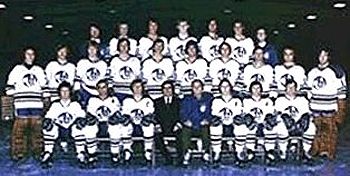
After purchasing the Cleveland Barons franchise in the AHL, owner Nick Mileti , who also owned the NBA's Cleveland Cavaliers, attempted to buy a franchise in the NHL. When that plan did not pan out, he instead bought a franchise in the newly created World Hockey Association. Unlike the franchises on Boston (New England), New York, Philadelphia, Chicago, Los Angeles and Minnesota, the Crusaders did not have to compete directly with an NHL club in their own back yard.
In addition to being the only show in town, the Crusaders made a splash by signing defenseman Paul Shmyr away from the California Golden Seals but really grabbed the headlines when the lured goaltender Gerry Cheevers away from the defending Stanley Cup champion Boston Bruins in arguably the most noteworthy signing by the WHA after Bobby Hull and Gordie Howe.
Gerry Cheevers
The club found a home at the aging Cleveland Arena, which was built back in 1937 and seated less than 10,000 fans. Backed by the strength of Cheevers goaltending, the Crusaders had a fine first season, finishing second in the Eastern Division with a 43-32-3 record while allowing the fewest goals against and averaging 5,287 fans per game. In the playoffs, they swept the Philadelphia Blazers in their final games in Philadelphia, but were dispatched easily by the New England Whalers 4 games to 1.

The inaugural Cleveland Crusaders of 1972-73
Still playing in the Cleveland Arena in 1973-74, the Crusaders slipped a bit in the standings, winning 37 games to a third place finish in their division, but attendance was up nearly 20% to 6,212. For the playoffs, the Crusaders faced the Toronto Toros, who had relocated at the end of the previous season from Ottawa, and the Toros ended Cleveland's season in five games.
Paul Shmyr battles for the Crusaders
For the Crusaders third season, the club debuted a new home, the Richfield Coliseum, 25 miles south of downtown. Their new arena had room for 18,500 fans and was one of the first with new luxury boxes. While it was rather far from Cleveland, it was hoped that fans from Akron to the south would also be willing to make the drive north to the new arena.
Despite dropping to a 35-40-3 record, the Crusaders finished second in the Eastern Division and were the final qualifier for the playoffs. As the lowest seed, they drew the #1 overall team, the Houston Aeros who had little trouble closing out the Crusaders 4 games to 1.
Although attendance rose with the move to Richfield, up to 6,931, it was certainly less than hoped for, as issues arose with the Coliseum. It's single concourse, which served both levels, quickly became crowded and many fans were often late arriving to games due to the two-lane rural highway which led to the arena, especially on days when the snow came in off Lake Erie, backing up traffic several miles. Additionally, the luxury boxes were at the highest level of the arena, making them actually the worst seats in the house.
The Richfield Coliseum
For the 1975-76 season, Mileti sold the club to Jay Moore, but it was more of the same for the Crusaders on the ice, as they posted a nearly identical 35-40-5 record while finishing a narrow second to the Indianapolis Racers for the Eastern Division title as attendance sank to 6,356. The signs of real financial problems began to show themselves, which led to Cheevers leaving the club in mid season to return to the Bruins. The club then faced off against the Whalers in Preliminary Round of the playoffs, getting dumped in three straight games, bringing and end to the Crusaders after four seasons.
Moore then sold the club back to it's original owner Mileti, but for the 1976-77 season, it was announced that the NHL's California Golden Seals were moving to Cleveland to become the Barons, and would be setting up shop at the Coliseum. Knowing the city could not support two professional clubs, Mileti's proposed sale, which would have moved the team to Florida, fell through and the franchise eventually was relocated to St. Paul, where it became the second incarnation of the Minnesota Fighting Saints.
Today's featured jersey is a 1975-76 Cleveland Crusaders Kyle Moffat jersey. The Crusaders jerseys can be divided into two periods, with their first two seasons sporting three stripes in the "Northwestern" pattern and the last two seasons with a single bold stripe on the arms and waist as seen on today's featured jersey.
photo courtesy of Classic Auctions
Today's video section begins with footage of the Crusaders in action, where the narrator insults your intelligence by explaining what a "faceoff" is. Note the three stripe pattern on the Crusaders jerseys.
Pay no attention to the fact that there's chicken wire fencing at the end of the rink!
Want to watch Cheevers eat lasagna with his family and sign some mortgage papers? Sure you do. Here's an in-depth 21 minute profile of Cheevers which finally gets around to hockey after somewhat excruciating, unedited 13 minutes...
Labels:
Cleveland Crusaders
Tuesday, January 18, 2011
1975-76 Cleveland Crusaders Paul Shmyr Jersey
The arrival of the World Hockey Association was a blessing for many players, such as those toiling in the minor leagues, unable to crack an NHL roster. Others who benefitted were those already in the NHL in need of a sizable raise, a chance to be a "big fish in a small pond" or simply a change of scenery.
One such player was Paul Shmyr, born on this date in 1946. Shmyr began his professional career after playing with the New Westminster Royals in junior hockey when he joined the Fort Wayne Komets of the IHL. The hard-nosed defenseman played 70 games, scoring 22 points and being whistled for 91 penalty minutes and was a part of the Komets run to the Turner Cup Finals in the postseason.
He spent the next two seasons with the Dallas Black Hawks of the CHL. His 46 point, 118 penalty minute season led to a call-up by the Chicago Black Hawks for his NHL debut with three games, during which he scored his first NHL goal.
Shmyr while wearing #23 early in his career with Chicago
The next season saw him play another 48 games in Dallas as well as 24 games with Chicago plus an additional seven playoff games. The improvement in his game led to him being with the Black Hawks full time in 1970-71 where he got into 57 games, scoring his second NHL goal as well as a dozen assists plus an additional nine playoff games.
Just when it looked like Shmyr had found a home in the NHL, things changed when the West Division champion Black Hawks traded Shmyr to the California Golden Seals, easily the worst team in the NHL.
While life in California certainly meant more playing time for Shmyr, and a resultant increase in both points, with 27, and penalty minutes, his first season over 100 with 156, the team failed to qualify for the playoffs as they finished 47 points behind his former club in Chicago.
Perhaps it was the white skates that led Shmyr to want to leave the Golden Seals
It was then that Shmyr jumped to the rival WHA for the league's inaugural 1972-73 season, joining the Cleveland Crusaders franchise, with a roster consisting of absolutely no one you've ever heard of outside of former Boston Bruins goaltender Gerry Cheevers.
The inaugural Cleveland Crusaders of 1972-73
And with that leap of faith in the brand new franchise playing in a brand new league, Shmyr's career was transformed. The wide open style of play in the WHA allowed Shmyr, who was named team captain and the only one the team would ever have, to set a personal high in points with 48, while the brawling, rugged element of the league also saw him set a career high in penalty minutes with 169. Following the season he was named to the WHA First All-Star Team.
1973-74 was a near repeat of the previous season, only this time he set a career high in goals with 13 on his way to 44 points, 165 penalty minutes and another berth on the WHA First All-Star Team.
Shmyr defending for Cleveland against the Minnesota Fighting Saints.
Note the clear boards in the St. Paul Civic Center.
Shmyr was then rewarded with a spot on Team Canada for the 1974 Summit Series versus the Soviet National Team prior to the 1974-75 season. He was limited to 49 games but rebounded the next season with 70 games and a new personal high in points with 50 and his third WHA First All-Star Team selection. He was also named the recipient of the Dennis Murphy Trophy as the WHA's Top Defenseman for 1976.
With the financial troubles of the Crusaders on the rise, Shmyr, who was owed money by Cleveland declared himself a free agent and signed with the San Diego Mariners of the WHA.
With the Mariners, Shmyr tied his career high in goals with 13 and his career high from the previous season in points with 50. Following the season, the Mariners folded, and the free agent Shmyr signed on with the Edmonton Oilers where he would again be named team captain. Two more rock solid seasons followed with 49 and then 47 points, as well as two more 100+ penalty minute seasons, his sixth and seventh consecutive while a member of the WHA.
Can anyone explain the Russian captain's "K" on Shymr's Oilers jersey?
While Shmyr's franchise remained in business for the 1979-80 season, his league did not, as the four surviving WHA teams were admitted into the NHL as the WHA ceased to exist. With the former WHA severely limited in the number of players they could protect, he was claimed by the Minnesota North Stars who held his NHL rights.
He was installed as the North Stars team captain, providing much needed leadership to a young squad. Shmyr played well in Minnesota, appearing in 63 games and finished the season with a +25 rating. After one more season with the North Stars, he signed as a free agent with the Hartford Whalers, a former WHA franchise, for his final season before retiring.
Shmyr played seven NHL seasons and all seven in the brief history of the WHA. His combined numbers show 854 games played, 74 goals and 320 assists for 394 points as well as 1,388 penalty minutes, a testament to his rugged play.
Today's featured jersey is a 1975-76 Cleveland Crusaders Paul Shmyr jersey as worn during the season he was named the WHA's top defenseman.
The original Crusaders sweaters had "Northwestern" style stripes on the arms and waist, with a thicker black stripe bordered by two thinner purple ones separated by white spaces for their first two seasons. They also had black names to contrast their purple numbers.
They then simplified their design in 1974-75 with one thick purple stripe on both the arms and waist as well as making the names purple as well, with the only black remaining being the collar and the outer circle and shield of the crest.
In our video section today, Shmyr explains his departure from Clevleand and discusses the Mariners training camp and violence in hockey.
Oh yea, time to get funky with the 1973-74 Cleveland Crusaders. Love the way the announcer is trying to explain the game to the viewer. Note the "Northwestern" stripes on the first generation Crusaders jerseys.
AND IS THAT CHICKEN WIRE FENCING AT THE END OF THE RINK? What the hell!
Labels:
Cleveland Crusaders,
Shmyr
Subscribe to:
Posts (Atom)

